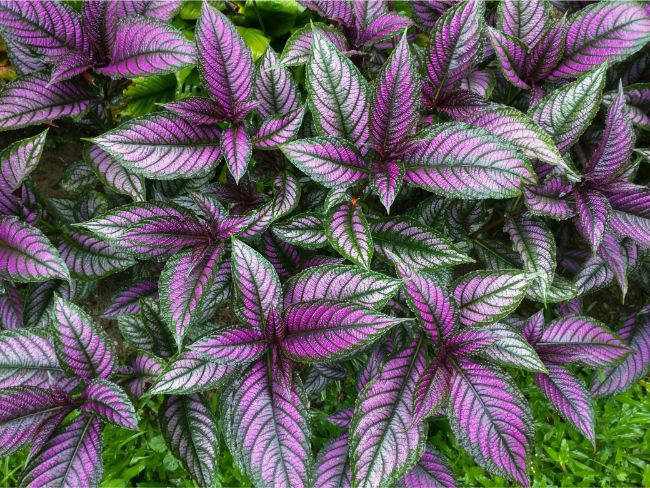Flowers aren’t the only way to have stunning color in your garden or home. The attention-grabbing Persian Shield (Strobilanthes dyerianus) has iridescent purple foliage that lasts all season long. Indoors or out, it works as a brilliant accent or stunning centerpiece to give any setting an exotic tropical ambiance.
How do you grow Persian Shields? Plant persian shield in partial shade and rich, moist soil. It prefers warmth and humidity yet can take some cold weather, and it’s resistant to disease and pests. It needs overwintering and fades after a few seasons, but grows quickly and easily propagates.
The Persian Shield is perennial in warm climates and makes an excellent houseplant year-round. It’s choosy about its light and needs some attention to look its best … we’ll explain all that below. Overall, it’s an easy-to-keep plant that will have people talking.
Persian Shield Overview
The Persian Shield’s shimmering foliage offers the vibrancy of flowers—and you don’t have to wait for blooms. It requires a lot of moisture and partial shade, but otherwise it’s not fussy. They look great in outdoor borders or as a splashy backdrop, and make excellent houseplants too.
The plant can produce violet cool-season flowers, but the foliage is unquestionably its highlight. The tipped leaves have a metallic sheen over a dark green base with a vivid purple and silver overlay; they are warm lavender underneath.
Strobilanthes grow quickly in warm, humid conditions. Outdoors they can reach five feet high and nearly as wide, but remain smaller as potted houseplants.
Though more tolerant of cool temperatures than many tropicals—they can overwinter outdoors in mild zones—you’ll have to bring houseplants indoors before frosts begin. If you give them plenty of light and moisture indoors, they’ll provide your home with a continual show of color.
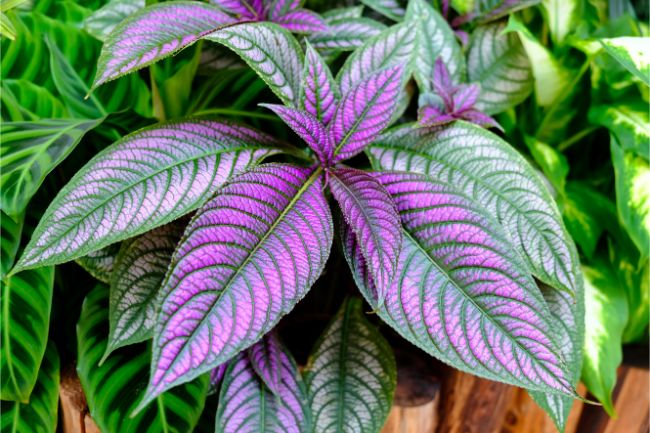
Persian Shield Care Needs
- Scientific Name: Strobilanthes dyerianus
- Common Name: Persian Shield Plant
- Origin: Myanmar
- Light Requirements: Bright indirect light. Can tolerate some direct sunlight, particularly indoors.
- Watering: Keep soil evenly moist. Water once the surface of the soil starts to dry. Will wilt significantly if underwatered.
- Soil: Well-draining commercial potting mix.
- Temperature: 60-75°F (16-24°C) is ideal.
- Fertilizer: Fertilizer every 3-4 weeks during the growing season with a balanced fertilizer at half strength.
- Humidity:Prefer humidity greater than 40%.
- Pruning: Prune regularly during the growing season to maintain compact growth.
- Propagation: Leaf propagation works well but needs close supervision.
- Re-Potting: Repot every 1-2 years. Increase pot size if signs of becoming root-bound.
- Diseases and Pests: Very resistant to pests and diseases when actively growing.
- Toxicity: Non-toxic. Safe for humans and pets.
- Where To Buy: Buy a Persian Shield Plant online at Etsy (I buy most of my houseplants from Etsy).
Characteristics Of Strobilanthes Dyerianus
The Persian Shield is a fast-growing, soft-stemmed perennial from the family Acanthaceae. The plant’s original habitat is the bright, filtered shade of a forest canopy in its native Myanmar, growing in rich organic soil under warm, moist tropical conditions.
Its common name refers to the metallic-sheened broad leaves that are shaped like a shield. The leaves grow from 4 to 8 inches long and are slightly serrated with green veins and both purple and silver tones across the upper surface.
The plant can be found in nurseries, but it’s not extremely common. There are no variations of this beautiful plant.
Outdoors it does best in early morning or late afternoon sun with shade in the heat of the day. Direct sun will fade the purple into a silvery grey (though the sheen remains). Indoors, it needs a sunny window or substantial artificial light.
Persian Shields like organically rich and well-draining soil that’s kept moist: they wilt quickly in dry conditions. They need humidity to look their best. I’ve previously written about the best ways to increase humidity for your indoor plants.
They’re easy to keep bushy and compact with basic pruning. The stems become woody and leaf color fades with age, but they propagate readily from cuttings.
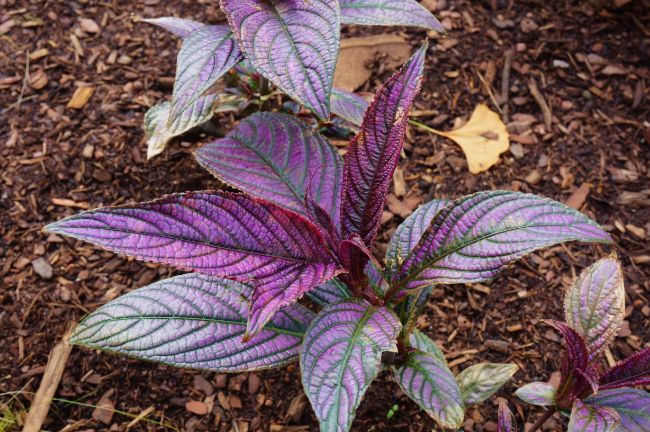
Persian Shield Requires Bright Light
The Persian Shield likes bright indirect light but does well in a range of conditions.
Outdoors, southern locations need the protection of partial shade or dappled light: too much sun fades the deep purple color into a silvery cast. They’ll take some full sun as you move north; if in doubt, choose a more shaded spot. An area that gets full early morning sun and light shade through the afternoon usually works well.
An indoor Persian Shield likes a sunny window, but keep it away from hot, direct sunlight. A grow light can supplement the intensity. You can gauge whether the light is sufficient by observing how compact the plant remains. Rotate their pot to keep them from stretching.
How To Water Persian Shield Plants
Strobilanthes likes a lot of moisture both in the air and soil … even so, to avoid pests and disease, it’s best to let the top inch or two of soil dry between waterings.
The plant will teach you the right watering schedule: it droops whenever it’s thirsty. It will collapse into a sorry heap if you wait too long, but it springs back if you catch it in time. The time-lapse video below shows you how dramatic their recovery can be.
It’s not a good idea to let this happen every time, of course, but observing signs of wilting helps you find a schedule to keep the plant suitably moist.
The best way to water a potted Persian Shield is to put a saucer beneath it and pour water over the topsoil. Make sure the water runs through and saturates the medium. Use room-temperature, dechlorinated water and avoid getting it on the leaves.
Outdoor mulching helps keep the soil evenly moist, though you won’t need it inside. You’ll find yourself watering quite a bit in hot weather, but reduce it over the winter. Inside or out, they rest during the cool season and expect drier soil.
Rich, Friable Soil
Strobilanthes likes to live in arable organic soil, and it’s not hard to make them happy. A good commercial potting mix does fine for containers. They like a pH range of 5.5 to 7.5.
The ideal medium holds moisture but drains well. If your mix is a bit heavy, consider adding compost, peat moss or vermiculite to give it the right springy texture. Ensure their pot has sufficient drainage holes, too.
If you’re planting outdoors, compost and leaf mould are the most suitable and affordable amendments. Pay attention to drainage. They like moist bedding but won’t tolerate sogginess for long.
Persian Shield Temperature Needs
The Persian Shield is a tender perennial that prospers in our comfortable temperatures indoors. They do best from 60-75 °F (16-24°C) yet can shrug off short dips below this range. They tend to get leggy in hotter weather.
Outside, they are hardy in USDA Zones 10 and up, though anecdotal reports claim Strobilanthes are becoming perennial in Zones 8 and 9. They can die back after a mild frost and recover in spring, but too much cold weather will stunt them. Plan on overwintering indoors—or restarting—if your winters are rough.
Potted plants should be brought inside when temps begin dipping, well before the threat of frost.
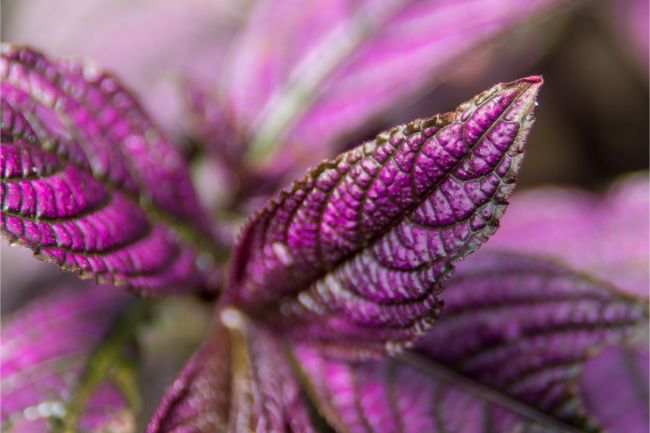
Light Balanced Fertilization
Rich organic soil provides a nutrient base for both outdoor or potted Persian Shields, so don’t skip that. Fertilization won’t make up for poor soil: they respond best to a light regime.
Some owners use a slow-release fertilizer every quarter during the warm season—this works better for outdoor settings, where the roots have more scope.
Potted specimens need a gentle fertilizing boost more than outdoor plants, and prosper on a 2-3 week feeding schedule from spring through fall.
Use a balanced liquid or water soluble fertilizer made up at half the recommended strength, and apply when watering to avoid root burn. A balanced formula is best to promote root growth and leaf color.
Reduce feeding in late fall, and hold off completely over the winter months. Persian Shields naturally rest during cool weather, so extra fertilizer will just build up in the soil.
Persian Shield Humidity Requirements
Persian Shields love humidity, but they aren’t as hard to please as many tropicals. They do well with 40% humidity (though higher is even better). If the humidity is too low, their leaves become crispy, so gauge accordingly.
Adequate watering in well-mulched soil satisfies outdoor plants, but indoors the challenge isn’t so bad, either. You’ll always get great results with a room humidifier, but Shields are usually satisfied with a simple water tray.
Put a layer of pebbles in a saucer that’s a little larger than their pot, and fill it with water so the rocks are just above the surface. Place the container on the pebbles. This keeps the potting soil and roots out of the water as evaporation lifts moisture into the local air.
Incidentally, misting isn’t very helpful for these plants: it dissipates before it makes a difference and can discolor leaves if the droplets are too large, too cold, or contain contaminants.

Does Persian Shield Flower?
The Persian Shield is grown for its royal foliage, but it also has small flowers. These cone-shaped violet blossoms give rise to its less-common name, the Bermuda Conehead.
The best thing about their flowers is that they arrive with cool weather. It’s less a rush of color than a wintertime novelty, but they’re welcome … when they show up.
Its foliage can remain beautiful in less-than-ideal conditions, but these plants only bloom when warm and ebullient: you may never see flowers. Some owners snip the flower spikes off, as with Coleus—but don’t. The small leaves and blossoms are a harbinger of next season’s vigor.
Pruning Strobilanthes dyerianus
A pot well filled with Strobilanthes is a beautiful sight, but the plant doesn’t cooperate without pruning assistance. It’s easy to do—the only trick is timing. Pruning is best done while the plant is active—well, it can be done at any time, but the stem can die if cut during their dormant state.
Cutting the growing tips during spring and summer encourages lateral branching and creates a bushier plant. Trim the stem at an angle just above a leaf.
One exception to the only-during-growing-season rule is cutting back at winter’s end. If you prune them to a foot high, leaving some foliage for recovery, they will boldly rebound with the coming spring.
Sometimes an older or rootbound Persian Shield will resist your pruning efforts and insist on leggy growth. Rather than imposing drastic measures, consider repotting or starting fresh with leaf cuttings.
Propagating Persian Shield Is Easy But Requires Attention
There are two reasons to regularly propagate Persian Shields: to replace older plants that grow woody and faded, and to grow cuttings for a new season.
Though not overly difficult to propagate, Strobilanthes do need some help getting started. Leaf propagation is the standard method.
Here’s how:
• Take a stem tip cutting two to five inches long.
• Wash the section carefully to remove hitchhiking pests. Strip away the bottom leaves.
• Insert into conditioned, room-temperature water. Change the water every 24-48 hours.
• Once the cutting has a small set of roots, place it in a light potting mix. Their roots develop better in soil.
• Water lightly. Place the container in a clear plastic bag under good indirect light.
• Remove the cutting from the bag an hour each day—it’s a pain, but helps keep them from molding. Optional: If you’re having trouble, consider using a heat mat to speed root growth.
• After three to five weeks, remove the plastic bag. Keep the soil extra moist for a couple of days and then treat it like a mature plant.
Success depends upon high warmth and humidity, good light, and your ability to keep them from rotting.
Pro Tip: Do many leaves at once: you can always give them away.
Repotting: Use Deep Containers
The basic rule for Persian Shields is to repot a size larger in the spring if you see surface roots. Gently open the root ball if it’s potbound, and plant at the same depth as before. If you want to keep the plant small, repot less often.
One important tip is to use deep containers. Strobilanthes roots can stretch deeply: the extra soil helps preserve adequate moisture as the top few inches dry out.
Planting Tips
- If kept warm (or indoors), the plant grows larger and more impressive in its second and third year.
- Outdoor Persian Shield plants tend to be stunted after a severe die-back from frost … if you’re in a marginally hardy zone, consider restarting them as annuals each spring.
- When grown as an annual from autumn leaf cuttings, Persian Shields get about a foot high the following summer. They’ll grow faster in warmer weather, but annuals usually look best in a border. Plant in masses for effective color.
- Remember that, indoors or out, warmth matters a lot to this plant. In Florida they thrive in damp, shady spots where they would languish further north. Houseplants can take more direct window sun in colder locales.
- Wash the plant thoroughly and apply insecticidal soap when bringing them in from the wild outdoors. Strobilanthes are resistant to hungry pests, but they do have them. You don’t want that fight.
- Another fight to avoid is over where your Persian Shield will live indoors. It’s better to move their pot around until it “tells” you it’s happy.
- Persian Shield plants do fine in artificial light, but they need a lot. Keeping them near a window and supplementing light is a reasonable choice.
- Expect some leaf drop when you bring an outdoor specimen inside.
- Some owners report success with water retention granules. These give a cushion to the casual gardener, but they only last a few seasons.
- Don’t expect a lot of pizzazz in the cool season: dormant Strobilanthes are lackluster. Even as houseplants they’ll seem to fizzle. Newbies may think their plant is dying and throw it out when it’s just resting for a glorious new season.
Common Questions
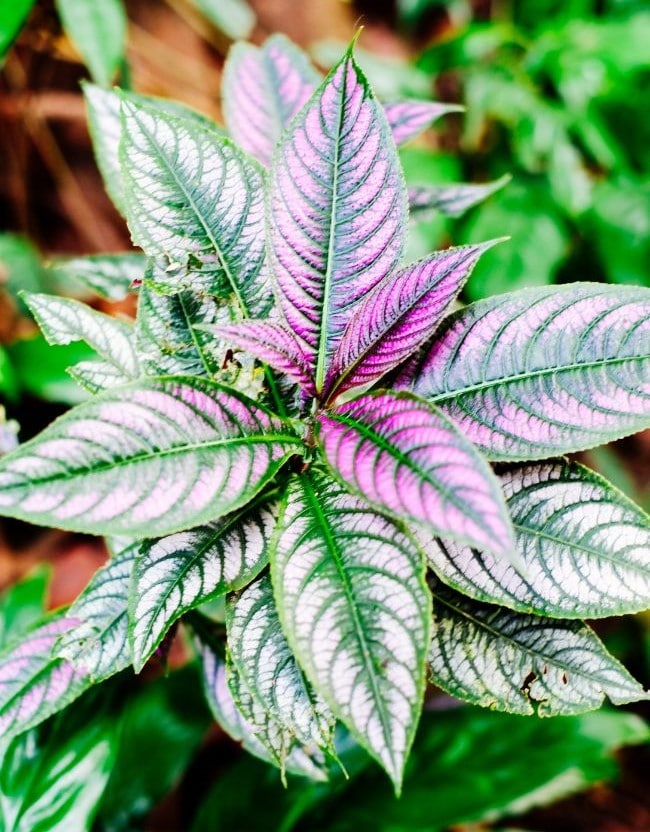
What Are The Main Diseases And Pests Of Strobilanthes?
Persian Shields seem impervious to pests and diseases! The main issues come during dormancy. Cool weather can bring spider mites, fungus, and gnats: treat with horticultural soap or pyrethrum spray.
Why Does My Persian Shield Have Discolored Leaves?
Though disease can cause discoloration, Strobilanthes are fairly resistant to pathogens. Here are more common reasons:
- Too much light will fade leaves.
- Dry air can cause leaves to curl at the edges or turn brown and crispy.
- Old leaves decline before they fall off—this is natural.
- Lack of fertilization—or an unbalanced formula—can cause leaf discoloration; too much fertilizer can burn leaf edges.
- Spotting is usually from water damage. Cold water is a common culprit; lingering water drops under direct sun is another.
Are Persian Shield Plants Poisonous?
The Acanthaceae family isn’t considered toxic, though their sap may irritate sensitive skin.
Creative Combinations With Persian Shield Plants
Persian Shields are a striking focal point of a mixed arrangement. Here are some ideas:
- The vivid purple contrasts well with lime-green foliage like Sweet Potato Vine.
- Combinations with Caladiums and Elephant Ears are stunning. Other striking companions are Oxalis and Lotus Vine.
- Combinations with blue or purple Impatiens or Petunias are magically harmonious.
- Yellow flowers offer a cool/warm contrast. Lavender Geranium or Petunia integrifolia are way hot.
- Planted together outdoors, Lycoris provides floral highlights all summer and evergreen cover in winter.

